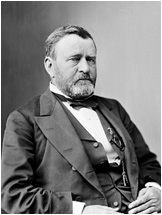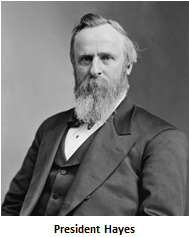

After the disaster of President Johnson, the United States electedInteractive popup. Assistance may be required. the 18th President of the United States. Even with the military rulers in place, the South continued to resist. If begrudgingly, they gradually began to meet the conditions of Radical Reconstruction and the states were readmitted to the Union. Over time, white Southerners were able to elect state governments that reflected their old ways. They were aided by a new, anti-black terrorist group, the Ku Klux Klan (KKK), which sought to intimidate freedmen through terrible violence.
Grant responded forcefully to the KKK. However, by the early 1870s the country was growing tired of spending resources trying to defend the rights of freed slaves and ending Southern resistance.
This was made worse by the collapse of the economy in 1873. Amidst hard times, Northern voters cared more about their own well-being than trying to aid the South. To make matters even worse for President Grant, his administration was rocked by multiple scandals.

Source: Rutherford B. Hayes
1870-1880 Restored
Grant remained personally popular, but between the poor economy and the scandals, he chose not to seek re-election to a third term in 1876. For the first time since the Civil War, a Democrat seemed to stand a chance in a national election.

The race was between Republican Rutherford B. Hayes and Democrat Samuel Tilden. Tilden actually won the popular vote, but fell one electoral vote short of the Constitutional majority needed to win. There were 13 electoral votes in dispute, sending the election to the House of Representatives. The House of Representatives, controlled by Republicans, established a committee on how to assign the 13 votes. There were 13 members on the committee, seven Republicans and six Democrats. The committee would vote, 7-6, to award all 13 disputed votes to Hayes and give him the presidency.
Obviously, many Democrats thought the election of Hayes was unfair. The Democrats agreed to not object to the committee's ruling in exchange for the following:
The Compromise of 1877 ended Reconstruction. After almost two decades of conflict, the North set its sights on making money and the great industrial expansion that was about to come. It left the South to conduct its own policies on race for almost the next century.